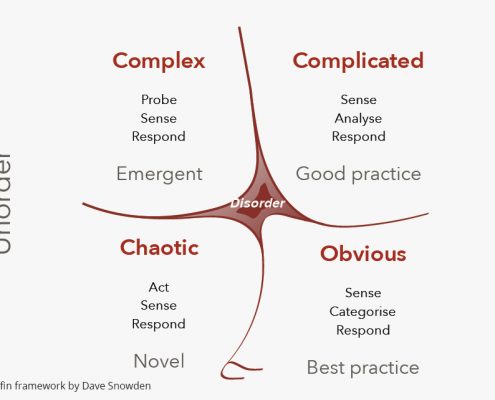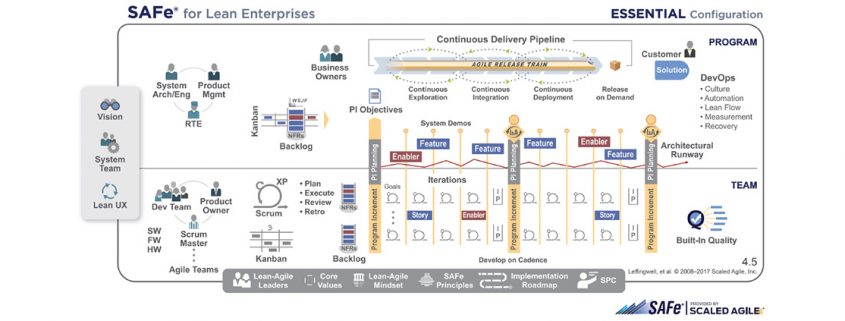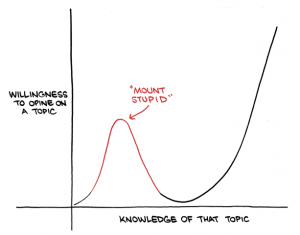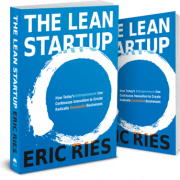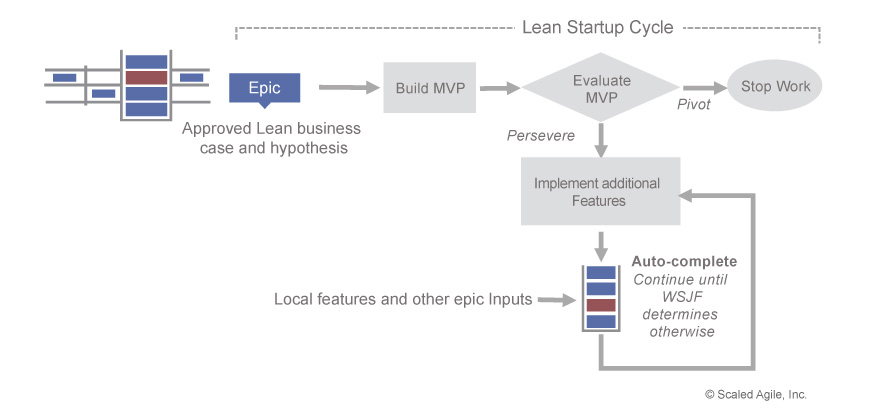Shifting the Burden – Using Systems Thinking to build high-performing teams
Systems Thinking provides us with useful insights how organizational systems work. The insights are often surprising in the way they help explain common dysfunctions in organizations. It is a pitty that beyond the field of organizational scientists it doesn’t seem to be very well known. Systems Thinking is part of the foundation of Agile: Agile scaling frameworks like LeSS and SAFe both explicitly mention Systems Thinking in their underlying principles. Yet, rarely do I come across agile coaches that even have a mediocre understanding of ST. Most have even never heard of it. If you really want to understand the barriers of agile in organizations, both Systems Thinking and Complexity Theory, also not that well-known, are crucial. Because even agile coaches or should I say especially agile coaches, fall into the traps of local optima and symptomatic solutions. So let’s explore how Systems Thinking can help in building high-performing teams.
If you have a headache and you take an aspirin and the headache goes away, then you might just be happy with that and not worry about why you had a headache in the first place. Next time you get a headache, you just take another aspirin, because it worked the first time. Pretty soon you will get used to it and always keep aspirin around and never look for a more fundamental solution to headaches. Taking aspirin will make it less and less likely that you actually adjust your health so that your body works right in the first place.
Systems Thinkers discovered patterns of cause-effect relationships in organizations that are called archetypes. Shifting the Burden is one such archetype, and the headache story above is an example of it. Here’s how it works: We have a problem symptom. There is a fundamental solution to the problem, although it usually works at a delay. The fundamental solution gets overlooked very often because of short-term thinking, pressure within the organization to come up with a quick fix, and a poor understanding of the relationship between cause and effect. Instead we ‘shift the burden’ to other solutions, easy fixes that seem to work well. Unfortunately we only deal with the symptom and not the underlying problem. Covered up by the symptomatic solution, the underlying problem grows worse unnoticed. We use more and more of the quick fix solution because that seemed to work, further reducing the pressure to seek a fundamental solution. Eventually the organization’s ability to solve the underlying problem gets undermined.
 Another common example in the agile world is a manager that is trying to empower teams by delegation. But as the team struggles he steps in to help them, with all good intentions. Over time this reduces the ability of the team to solve issues themselves. Instead they increasingly get more dependent on the manager. The overprotective scrum master is another well-known phenomenon in this category. Although often praised for the good relationship he or she has with the team and the great atmosphere in the team, the scrum master unintentionally effectively has become the leader of the team, with everyone depending on him or her.
Another common example in the agile world is a manager that is trying to empower teams by delegation. But as the team struggles he steps in to help them, with all good intentions. Over time this reduces the ability of the team to solve issues themselves. Instead they increasingly get more dependent on the manager. The overprotective scrum master is another well-known phenomenon in this category. Although often praised for the good relationship he or she has with the team and the great atmosphere in the team, the scrum master unintentionally effectively has become the leader of the team, with everyone depending on him or her.

The picture above is a causal loop diagram that explains the generic Shifting the Burden archetype. The diagram depicts the quick fix solution that temporally lowers the problem symptom, and the fundamental solution that would lower the symptom as well, although usually at a delay. There’s a side effect loop that shows we get more dependent on the quick fixes as we use them undermining our ability to address the actual underlying problem.
 Now let’s get back to our team. I have seen many teams like this where the team itself insists they are a strong team: they tell each other lots of stories about their private life, they have drinks together and organize the occasional team event. But if you observe the team a little closer you will notice most conversations are quite shallow, everybody’s playing nice to each other. The teams reaction to conflict is to cover it up. As a result the team does not learn how to deal with conflict. The more they revert to the symptomatic solution of smoothing things over, the less the team will be capable of working on a fundamental solution, which could be working on team cohesiveness by creating trust, coaching the team in conflict resolution and a shared sense of accountability for results. This is described in the first part of the diagram: causal loops B12 and B13.
Now let’s get back to our team. I have seen many teams like this where the team itself insists they are a strong team: they tell each other lots of stories about their private life, they have drinks together and organize the occasional team event. But if you observe the team a little closer you will notice most conversations are quite shallow, everybody’s playing nice to each other. The teams reaction to conflict is to cover it up. As a result the team does not learn how to deal with conflict. The more they revert to the symptomatic solution of smoothing things over, the less the team will be capable of working on a fundamental solution, which could be working on team cohesiveness by creating trust, coaching the team in conflict resolution and a shared sense of accountability for results. This is described in the first part of the diagram: causal loops B12 and B13.
In a complex system however all parts of the system are interconnected and a change in one part can inadvertently lead to a problem elsewhere. We often find series of interconnected shifting-the-burden structures where one fundamental solution is another problem’s symptomatic solution.
So how does the fundamental solutions become the symptomatic solution of another problem? While team cohesiveness grows a team identity starts getting developed. They slowly develop a ‘them-against-us’ mentality towards other teams or the surrounding organization. People outside of the team start perceiving the team as inward-thinking, taking care of only themselves, even if not in the interest of the larger organization. Conflict with the rest of the organization starts to grow.
The fundamental solution of building team coherence to the conflicts-within-the-team-problem has now become a symptomatic solution of a new problem: conflict between the team and it’s environment (causal loop B15). The team tries to deal with the new conflict by closing their ranks, sticking together, which in the ends only decreases their ability to fundamentally deal with the rest of the organisation in a constructive manner.
So now we need to look at a fundamental solution to his problem, like helping the team to build a better understanding of the part they play in the larger organization (causal loop B16). You could encourage the team to explicitly define some of their team goals as contributions to higher organisational goals. This is actually a very powerful way to deal with the issues we inherit from today’s silo organisations: give teams or departments a goal they cannot achieve by themselves, but only by collaborating with others.
This practice is in contrast with the popular agile practice of giving teams their own domain to focus on. We are strongly apposed to this. The logic behind it is to encourage teams to take ownership of their own area. But teams don’t work in isolation. They are part of a bigger whole, and this practice will unavoidably lead to local optimization and inward-focusing teams. Systems Thinking can help you understand and predict that.
Note that we covered only one Systems Thinking archetype in this article and only a fraction of the concepts behind Systems Thinking. Nevertheless there are valuable lessons for agile coaches or anybody working on high performing teams:
- Always focus on the fundamental solution vs a symptomatic solution. Withstand organizational pressure for quick solutions. There are no quick fixes to complex problems.
- Note that a fundamental solution often needs to be discovered. In many cases it is not a matter of analyzing, but of discovery through experiments.
- Be aware that the more one applies a symptomatic solution the less one becomes able to come up with a fundamental solution.
- Realize that a fundamental solution can at the same time be a symptomatic solution for another problem.
Do you want to know more on what Systems Thinking can do for your team and organization? Attend one of our Management 3.0 workshops.
Notes: [Martin Knapovsky. Shifting the burden archetype. https://www.knapovsky.com/shifting-the-burden-archetype/] [Daniel Kim. Shifting the burden revisited: Turtles all the way down. https://thesystemsthinker.com/shifting-the-burden-revisited-turtles-all-the-way-down/]




